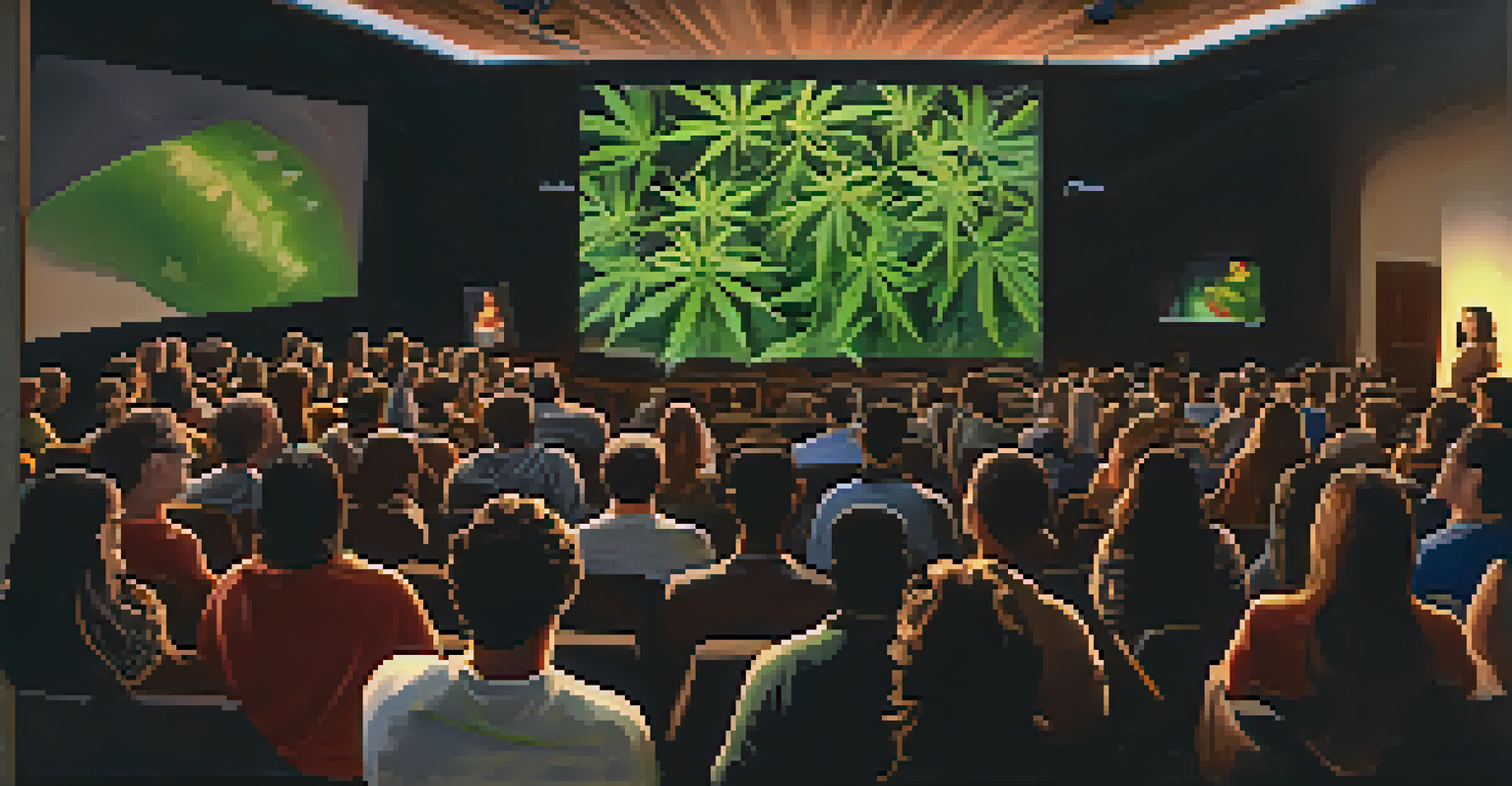The Role of Media in Shaping Marijuana Perception Today

Historical Context: Media's Role in Marijuana Perception
For decades, media portrayal has played a pivotal role in shaping public perception of marijuana. In the early 20th century, sensationalist films and articles often depicted cannabis users as dangerous or deranged. This negative framing contributed to widespread stigmatization, influencing legislation and public opinion for years to come.
The media is the most powerful entity on earth. They have the power to make the innocent guilty and to make the guilty innocent, and that’s power. Because they control the minds of the masses.
As the years progressed, the narrative began to shift, particularly with the rise of counterculture movements in the 1960s. Media channels started showcasing the benefits of marijuana in a more positive light, including its use for relaxation and creativity. However, this duality in portrayal created a complex landscape where both fear and acceptance coexisted.
Today, understanding this historical context helps us see how media not only reflects but also shapes societal attitudes towards marijuana. This evolution is crucial for grasping how current narratives continue to influence perceptions and policies surrounding cannabis.
Social Media's Influence on Cannabis Conversations
In recent years, social media platforms have become powerful tools for shaping public opinion about marijuana. With the ability to share personal experiences and information, users can easily spread awareness about the benefits and risks associated with cannabis use. This has created a more nuanced dialogue that often contrasts with traditional media narratives.

Influencers and advocates use platforms like Instagram and Twitter to share their stories, helping to normalize marijuana usage and dismantle stereotypes. Their reach and relatability encourage open conversations, particularly among younger audiences who may be more receptive to these messages. As a result, social media serves as a key space for education and advocacy.
Media Shapes Marijuana Perception
Historical and contemporary media portrayals significantly influence public attitudes and legislation surrounding marijuana.
However, the unregulated nature of social media can also lead to misinformation. While many users promote accurate information, others may share misleading claims, complicating the public's understanding of marijuana. Thus, it's essential for consumers to critically evaluate the sources of information they encounter online.
Mainstream Media: Balancing Facts and Sensationalism
Mainstream media plays a critical role in shaping marijuana perceptions through news coverage and documentaries. While some outlets strive for balanced reporting, others may sensationalize issues related to cannabis, such as crime or health risks, to attract viewership. This can skew public perception, reinforcing negative stereotypes.
If you don’t like the news, go out and make some of your own.
On the flip side, there are also numerous documentaries and articles that highlight the medical benefits of marijuana, showcasing real-life stories of patients who have found relief through cannabis. These narratives can help humanize the discussion around marijuana and challenge existing prejudices, particularly among older demographics who may hold onto outdated beliefs.
Ultimately, the challenge lies in finding a balance between reporting facts and engaging viewers. As audiences become more discerning, they increasingly demand content that not only informs but engages in a meaningful way. This shift encourages media outlets to approach marijuana narratives with greater responsibility.
The Role of Advertising in Shaping Marijuana Views
The legalization of marijuana in various regions has opened the door for advertising opportunities, which in turn shapes public perception. Cannabis brands are now using marketing strategies similar to those in other industries, aiming to create a positive image around their products. Effective advertising can help demystify marijuana and promote its benefits, particularly among those who may be skeptical.
However, the challenge lies in navigating regulatory frameworks that govern cannabis advertising. Brands must strike a balance between promoting their products and adhering to restrictions designed to protect consumers. This adds an interesting layer to how marijuana is perceived, as some advertisements may be seen as pushing boundaries.
Social Media Fosters Open Dialogue
Social media platforms enable users to share personal experiences, creating nuanced conversations about the benefits and risks of cannabis.
As cannabis advertising continues to evolve, it will be fascinating to observe how it affects public perception over time. A well-executed campaign can transform attitudes, but it also risks backlash if perceived as trivializing the subject matter.
Documentaries and their Impact on Public Awareness
Documentaries have emerged as a powerful medium in changing perceptions about marijuana. By providing in-depth analysis and real-world stories, they offer viewers a comprehensive understanding of cannabis, its benefits, and its challenges. With titles such as 'Weed the People' and 'The Business of Drugs,' filmmakers have sparked conversations that challenge long-held misconceptions.
These documentaries often highlight personal stories, such as those of patients seeking alternative treatments for chronic conditions. By humanizing the discussion, they foster empathy and understanding, encouraging viewers to reconsider their stance on marijuana. This emotional engagement can be a potent catalyst for change in public attitudes.
As more people turn to streaming platforms for content, the accessibility of such documentaries has significantly increased. This trend allows for broader reach and engagement, making it easier for individuals to explore diverse narratives surrounding marijuana and its role in society.
Legislation and Media: A Symbiotic Relationship
The relationship between media and legislation surrounding marijuana is complex and often symbiotic. Media coverage can influence political discourse, prompting lawmakers to reconsider outdated policies and attitudes. As public opinion shifts, often driven by media narratives, politicians may feel pressured to support legalization or reform efforts.
Conversely, new legislation often garners media attention, which can further shape public perception. As states legalize cannabis, the media reports on the impacts—whether positive or negative—creating a feedback loop that affects future discussions. This dynamic emphasizes the importance of responsible journalism in framing these narratives.
Grassroots Movements Amplify Voices
Community-driven initiatives challenge mainstream narratives, promoting more inclusive discussions about marijuana and its impact on society.
Ultimately, the interplay between media and legislation highlights the powerful impact of public discourse in shaping societal norms. As marijuana becomes more accepted, the role of media as an influencer in this dialogue cannot be understated.
Community Voices: Grassroots Movements in Media
Grassroots movements have become increasingly influential in the media landscape surrounding marijuana. Community organizations and activists are leveraging various media platforms to share their messages, advocate for policy changes, and educate the public. This grassroots approach often resonates more with local populations than mainstream narratives.
By amplifying the voices of those directly affected by marijuana laws and stigmas, these movements create a more diverse dialogue. They tell stories of individuals who have faced incarceration, discrimination, or health challenges due to cannabis policies. This personal touch helps humanize the issue and encourages empathy among audiences.

As community voices continue to gain traction, they challenge dominant narratives and push for more inclusive discussions about marijuana. This shift not only alters public perception but also influences the policies that govern cannabis use in various regions.